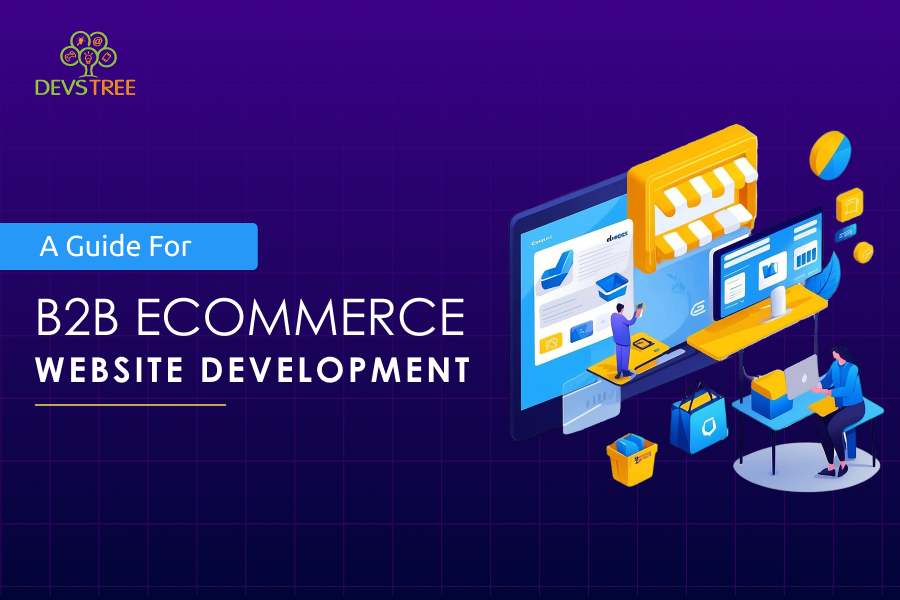B2B eCommerce websites are becoming essential for businesses trying to optimize their buying and selling procedures in today’s business environment. Business buyers of today require more than just an online product list. They want buying experiences that are simple, quick, and tailored to them, much like they get from their preferred business-to-consumer websites.
To carry out business operations efficiently, B2B entrepreneurs must overcome several obstacles every day. Regretfully, making a B2B eCommerce Web development is a challenging task that even seasoned developers encounter along the process. We’ll go into great detail in this blog post on how to fulfill every need of business clients.
How to Create a Website for B2B E-Commerce:
Organizing Your Website for B2B E-Commerce:
Before developing a B2B e-commerce website, stand back and clarify your company objectives. What do you want to accomplish? greater income, quick expansion, or building a significant competitive edge in your industry? Once your goals have been determined, outline your strategies for developing B2B e-commerce and install key performance indicators (KPIs) to track your advancement.
It is important to conduct thorough competition and market research since your ability to understand consumer preferences, industry trends, and rival strategies will determine how successful you are. Ultimately, you may select the ideal e-commerce platform to enable your B2B eCommerce website development company to grow if you have a clear vision and a thorough understanding of the market.
Develop a Data-Driven Approach:
A data-driven approach can help B2B organizations have a clear route when working on the construction of an e-commerce website development. Businesses can improve their performance in real time by generating predictions and insights through data-driven decision-making. This facilitates evaluating the efficacy of various strategies and identifying the ones that will yield fruitful outcomes. A successful plan should base its objectives and methodology on accurate calculations and reliable data.
User Experience and Design:
A user-friendly B2B E-commerce development service for websites must prioritize clear information architecture and easy navigation. Consider it as an easy-to-use map that directs users to the things they want, decreasing bounce rates and increasing user engagement.
Mobile responsiveness is essential; your website must work perfectly and provide easy navigation on all platforms, including computers and smartphones. Remember the B2B details: give priority to elements that will make sure your business clients have a seamless and effective purchasing experience, such as bulk purchase discounts, quote requests, and a fast checkout procedure.
Implementing B2B Features:
To meet the needs of other businesses, implementing B2B features in your company requires numerous essential components. To adjust prices based on market conditions, cost analysis, and customer value, bespoke pricing and negotiation are first and foremost necessary. Second, to let B2B clients manage their accounts, including user profiles, order history, and payment information, a strong account management system with role-based access is required.
Finally, to effectively track user assets and enable high-order value purchases, connectivity with payment gateways and buy-order systems is essential. Together, these elements improve business-to-business (B2B) interactions and facilitate more efficient corporate transactions.
Before Launching, Test:
Resolved problems and errors in your online business can prevent missed sales and damage your brand’s reputation, among other negative consequences.
So, regardless of how expensive or well-maintained your eCommerce system is, your QA team needs to test every little aspect in addition to the eCommerce test cases they already have to run.
If eCommerce site testing is allowed to run its course, your company will be at risk of performance and security compromises.
Maintenance and Optimization Following Launch:
After launch, the long-term success of your B2B website depends on maintaining and optimizing it. To address vulnerabilities and ensure system uptime, this calls for routine upgrades and security patches.
While iterative improvements based on data-driven decisions reduce bounce rates and promote client loyalty, gathering real-time input from users helps shape the business and fosters ties between customers and the firm.
To ensure continued success as the organization grows, scaling for growth entails reviewing and refining processes, tracking performance, and using the appropriate KPIs to influence decisions and marketing efforts. Together, these tactics support the B2B eCommerce business’s continued expansion and success.
Final Words:
Web development services begin with market research, target audience analysis, and company understanding. In the upcoming years, voice assistants, chatbots, and other AI technologies, along with personalization and B2B mobile eCommerce, are anticipated to dominate the B2B eCommerce development agency.
Your e-commerce website building costs will be recouped, and you will receive higher returns down the road with a scalable and versatile site. Do contact Devstree, an eCommerce web development company, if you wish to develop a B2B e-commerce website for your company.
